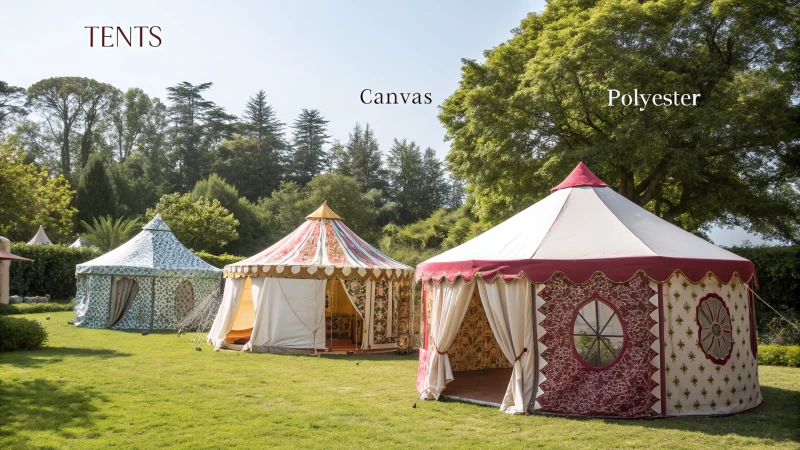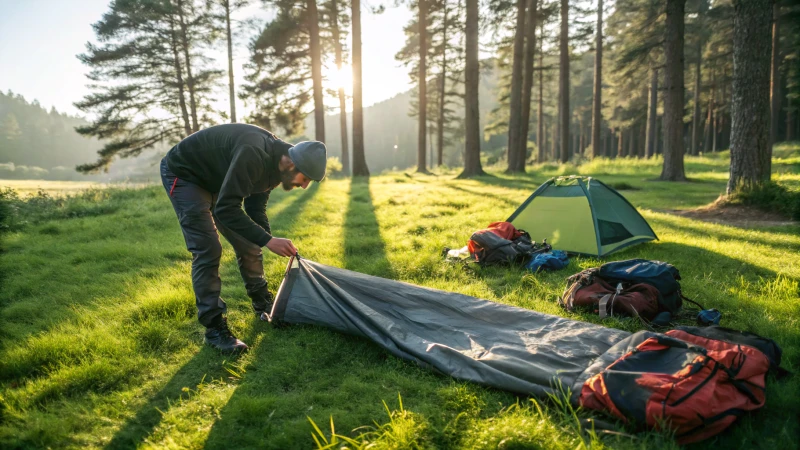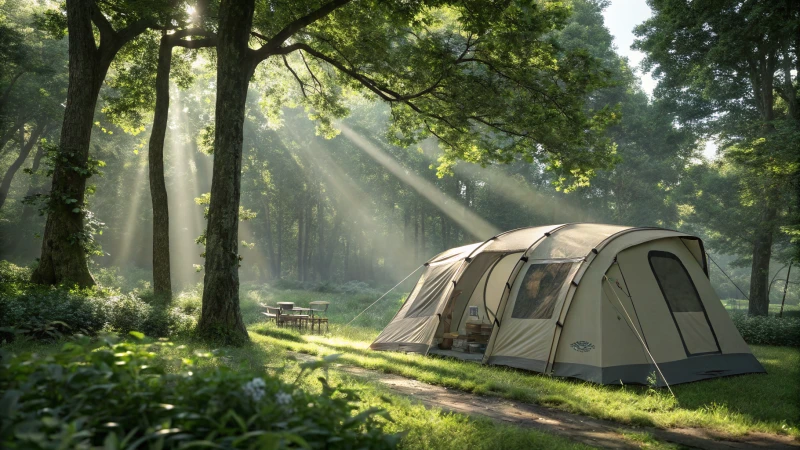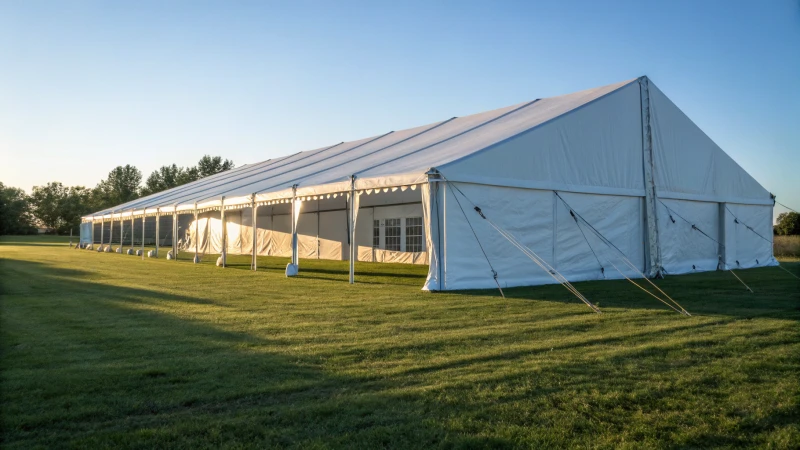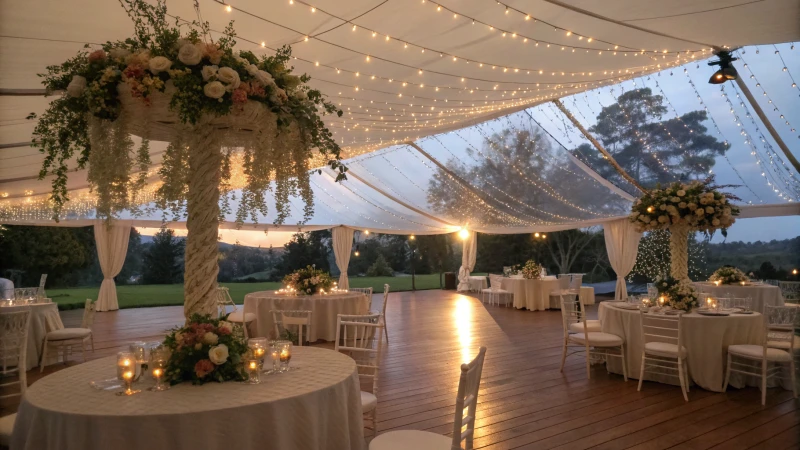
Imagine setting up a fully functional space in just a few hours, ready for anything from a wedding to an emergency shelter.
Temporary tent buildings are beloved for their quick setup, versatility, affordability, and eco-friendly nature. They cater to diverse industries like events, construction, and emergency services, offering flexible and efficient space solutions that outshine many permanent options.
I remember the first time I saw one of these tents in action at a friend’s outdoor wedding. It was incredible how quickly they transformed an open field into a magical venue, complete with lighting, flooring, and decor. This flexibility is what makes them so appealing across various sectors.
In my experience, temporary tents are not just about speed. They’re about providing a tailored solution to unique challenges. Whether it’s setting up a temporary warehouse at a construction site or creating a pop-up exhibition space, these tents offer unparalleled adaptability. Plus, knowing that they leave minimal environmental impact is a huge plus for anyone conscious about sustainability.
Diving deeper into specific industries, I’ve seen construction projects rely heavily on these structures to keep operations smooth and weatherproof. And let’s not forget their critical role in emergency response—providing immediate relief and shelter when it’s needed most. The combination of rapid deployment and cost-effectiveness truly sets temporary tent buildings apart as a go-to choice in today’s fast-paced world.
Temporary tents are more cost-effective than permanent buildings.True
Temporary tents require less material and labor, reducing costs.
Temporary tent buildings have a high environmental impact.False
They use fewer resources and are easily dismantled, minimizing impact.
Why Choose Temporary Tent Buildings Over Permanent Structures?
Choosing between temporary tents and permanent buildings is like deciding between renting a cozy cabin for a weekend or buying your forever home.
Temporary tent buildings are flexible and cost-efficient, perfect for short-term use, while permanent structures offer stability and long-term value. Your choice hinges on your specific needs, budget, and timeline.
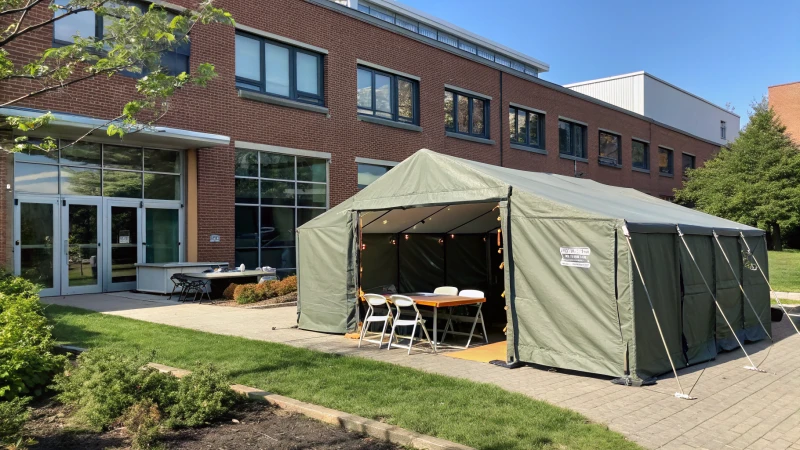
Cost and Budget Considerations
When I first started exploring options for expanding my business, the budget was a huge factor. Temporary tents immediately caught my attention because they were significantly easier on the wallet. Imagine needing extra space without the heart-stopping price tag of a full-blown construction project! The reduced initial investment means less financial stress and more room to breathe.
On the other hand, when you think about permanent structures, the costs can be intimidating upfront. However, their durability offers peace of mind that your investment will pay off over time. If you’ve got the capital and are in it for the long haul, this might be the way to go. For those interested in a detailed breakdown of temporary tent pricing1, industry reports offer some eye-opening insights.
Flexibility and Adaptability
There’s nothing quite like the flexibility of temporary tent buildings. I remember needing a space quickly for an unexpected business opportunity, and a tent was the perfect solution. Within days, we had a fully functional setup that could be dismantled or moved as needed.
Permanent structures, while stable, are less forgiving. Once they’re up, they’re there to stay unless you’re willing to shell out more cash for renovations. But if your needs are static and well-defined, their reliability is unbeatable. In contrast, clear span tents2 offer expansive, open interiors ideal for events that need a bit more flair.
Durability and Longevity
For projects where longevity is key, permanent structures are the gold standard. Built to endure decades of wear and tear, they’re what you want when stability is non-negotiable.
Temporary tents, though not meant to last as long, can hold their own in varying conditions with proper care. I’ve seen them withstand some pretty challenging climates—proof that with the right materials and maintenance, they can be surprisingly robust. More details on tent durability3 can be found in climate-specific resources.
Environmental Impact
Environmental concerns are at the forefront of many decisions today. Temporary tents leave a minimal footprint since they require no extensive groundwork. This was particularly appealing to me when considering sustainable practices.
While permanent structures might initially cause more environmental disruption, they can be designed with eco-friendly materials that benefit the planet in the long run. Exploring eco-friendly building practices4 can provide further guidance on sustainable choices.
| Feature | Temporary Tent Buildings | Permanent Structures |
|---|---|---|
| Initial Cost | Lower | Higher |
| Flexibility | High | Low |
| Lifespan | Short to Medium | Long |
| Environmental Impact | Minimal | Variable |
Use Case Scenarios
The decision between temporary and permanent often depends on specific scenarios:
- Events: Need a customizable space quickly? Temporary tents are your best friend.
- Warehousing: Seasonal storage needs? Tents fit the bill perfectly; but if you require constant access, a permanent warehouse might serve you better.
- Emergency Response: For quick deployment in crises, tents are indispensable. Their rapid setup was crucial during an emergency response project I worked on.
For more strategies on integrating both options effectively into event planning, consider checking out event planning5 resources.
Temporary tents are more cost-effective than permanent structures.True
Temporary tents require less initial investment, appealing to budget-conscious projects.
Permanent structures are more flexible than temporary tents.False
Permanent structures serve fixed purposes, while tents can be relocated easily.
What are the most common uses for temporary tent buildings?
Imagine transforming an empty space into a vibrant event venue or a bustling construction site with just a few sturdy poles and durable fabric. That’s the magic of temporary tent buildings.
Temporary tent buildings find their place in events, construction, agriculture, industrial storage, sports facilities, and emergency response due to their adaptability, quick setup, and cost-effectiveness.

Events and Exhibitions
Ah, the joy of planning a wedding or hosting a trade show! I’ve always loved how temporary tents can turn any landscape into a dream setting. Whether it’s an elegant wedding6 or a bustling concert, these tents can be tailored with flooring, lighting, and climate controls to create the perfect ambiance. It’s like having a blank canvas to create any masterpiece you envision, from cozy gatherings to grand spectacles.
Construction Sites
Working on construction projects, I’ve come to appreciate the versatility of temporary tents. They serve as shelters for equipment and provide safe havens for workers. Picture this: you’re out at a site, and the weather turns unexpectedly. These tents ensure that everything from expensive machinery to lunch breaks is well-protected. The speed at which they can be set up is a game-changer in our fast-paced world.
| Type | Use |
|---|---|
| Warehouse Tents | Equipment Storage |
| Worker Tents | Crew Break Areas |
Agriculture
Growing up around farms, I’ve seen how temporary tents become essential for protecting crops and livestock. They act like guardians against unpredictable weather, ensuring that everything inside thrives. From greenhouses nurturing young plants to shelters for animals, these tents offer an adaptable solution that keeps the agricultural wheels turning smoothly.
Industrial and Commercial Use
In my business experience, peak seasons often bring the need for extra space. Temporary tents come to the rescue by offering flexible storage solutions for goods and machinery. The ability to customize these structures means they can adapt as swiftly as business demands change, helping us manage logistics with ease.
Sports and Recreation
Whether it’s covering an outdoor pool or setting up an indoor skating rink, I’ve found temporary tents invaluable for sports facilities. They create year-round opportunities for activities regardless of the weather outside. These structures ensure that athletes and spectators stay comfortable, turning seasonal sports into evergreen pastimes.
Emergency Response
In urgent situations such as natural disasters or health crises, these tents play a crucial role. Their rapid deployment provides immediate infrastructure support—from medical stations to supply depots. Being involved in several community aid projects, I’ve seen firsthand how they transform chaos into organized relief efforts, bringing much-needed stability during crises.
Temporary tents are ideal for weddings and concerts.True
They offer customizable layouts and comfortable environments for events.
Construction sites rarely use temporary tents for shelter.False
These tents are commonly used as equipment shelters and worker facilities.
How Do Temporary Tents Contribute to Sustainability?
Ever wondered how a simple tent could be a game-changer for the planet? Let me take you on a journey where sustainability meets innovation.
Temporary tents contribute to sustainability by offering reusable, adaptable structures that minimize resource use and waste. They reduce environmental impact through low carbon footprints and efficient materials.

Reusability and Adaptability
Temporary tents are designed for multiple uses, making them a sustainable choice. Unlike traditional buildings, these structures can be disassembled, transported, and reused with ease. This adaptability reduces the need for new materials and construction, conserving resources.
| Feature | Traditional Buildings | Temporary Tents |
|---|---|---|
| Material Use | High | Low |
| Reusability | Limited | High |
| Carbon Footprint | Significant | Minimal |
Low Carbon Footprint
Setting up a tent feels like a breath of fresh air—literally. The materials used, like lightweight aluminum and PVC, have a significantly lower carbon footprint. I remember helping out at an event and seeing how quickly these structures came together with minimal fuss. Their assembly requires much less energy compared to the heavy machinery needed for permanent structures.
Efficient Use of Materials
Tents are built with materials designed for longevity. It’s like investing in a good pair of hiking boots—you want something that lasts and can handle the elements. The modular designs also mean that you can adjust the size without wasting materials, which is pretty neat. For example, clear span tents7 allow for wide-open space without needing support beams inside, perfect for all sorts of gatherings or storage needs.
Minimal Land Impact
One of my favorite aspects of using tents is how they preserve the environment. There’s no need to dig up the earth or lay down concrete foundations that disrupt the landscape. I once attended a festival where they used pagoda tents8 that blended seamlessly with the natural setting—an experience that left nothing but footprints behind.
Energy Efficiency
It’s fascinating how some temporary tents come equipped with solar panels and LED lighting. During an agricultural fair, I noticed how these energy-saving features helped reduce reliance on traditional power sources. Plus, the tents’ design often allows for natural light and ventilation, which is not just eco-friendly but also keeps things comfortably breezy in agricultural applications9.
Waste Reduction
The idea of waste reduction resonates deeply with me. Every time we choose a tent over a permanent building, we’re saying no to demolition waste and yes to a cleaner environment. I recall a story from a colleague who worked in disaster relief—using emergency tents10 meant they could quickly provide shelter while keeping sustainability front and center. It’s these small choices that add up to big changes.
Temporary tents have a high reusability rate.True
Temporary tents can be disassembled and reused multiple times, reducing waste.
Traditional buildings have a lower carbon footprint than tents.False
Temporary tents use fewer resources, resulting in a smaller carbon footprint.
What Innovations Are Making Temporary Tent Buildings More Functional?
Ever wondered how temporary tent buildings have become so sophisticated? Join me on a journey through the innovations making these structures more adaptable and efficient than ever before.
Temporary tent buildings are evolving with innovations like high-tech fabrics, modular designs, and smart features. These advancements enhance durability, flexibility, and efficiency, broadening their application across various sectors.

Advanced Fabric Technology
Imagine setting up a tent that can withstand the harshest weather conditions. Today’s tents use advanced materials that not only resist UV rays and flames but also offer superior insulation. I remember a time during an outdoor event when the sun was blazing hot, but the advanced fabric kept us cool inside—no extra air conditioning needed. These fabrics are game-changers for anyone needing reliable shelter in unpredictable climates.
Modular Design Systems
The beauty of modular design is like playing with building blocks as a kid—only now, these blocks create functional spaces for events or storage. I once had to quickly transform a large tent from a wedding setup to a corporate event venue overnight. The modular system made it so easy to swap out parts and reconfigure the layout without a hitch. This flexibility saves time and money, making it an invaluable asset in dynamic settings.
Smart Features Integration
Integrating smart technology into tents? Yes, it’s happening! Picture this: a tent equipped with solar panels and automated climate control. I’ve seen setups where energy-efficient lighting and environmental sensors ensure optimal conditions inside, no matter what’s happening outside. It’s like having a high-tech home under canvas, which is both fascinating and incredibly practical.
Enhanced Structural Engineering
Tents that can stand up to fierce winds and heavy snow—sounds impossible, right? Thanks to innovations in structural engineering, it’s now a reality. Think lightweight aluminum frames that are strong yet portable. I recall a project where we used these reinforced structures for an event in a mountainous region with unpredictable weather. The tents stood firm, providing safety and security for everyone involved.
| Innovation | Benefits |
|---|---|
| Advanced Fabrics | Durability, UV resistance |
| Modular Designs | Flexibility, ease of maintenance |
| Smart Technologies | Energy efficiency, environmental monitoring |
| Structural Engineering | Strength, portability |
Sustainability Considerations
In our ever-conscious world, sustainability is key. Manufacturers are moving towards eco-friendly materials and methods, which is a breath of fresh air—literally! I’ve seen the shift towards using recyclable materials for tent production first-hand. It’s not just about reducing the carbon footprint; it appeals to eco-conscious clients who prioritize green solutions. These sustainable practices make me hopeful for a future where every event or temporary setup leaves a positive impact on our planet11.
Temporary tent buildings are becoming more versatile and tailored to specific needs thanks to these innovations. Whether enhancing durability or integrating smart tech, each development is a step towards more efficient and sustainable temporary structures. As we push the boundaries of what these tents can do, I’m excited to see how they’ll continue to evolve to meet diverse needs across industries.
Modern tent fabrics are UV-resistant and flame-retardant.True
Advanced fabrics in tents offer UV resistance and flame retardancy.
Modular tent designs reduce assembly time significantly.True
Modular designs allow rapid assembly, enhancing flexibility and efficiency.
Conclusion
Temporary tent buildings offer quick setup, versatility, and cost-effectiveness for various applications, including events, construction, and emergency response, while minimizing environmental impact and maximizing adaptability.
-
Understand the cost dynamics of temporary tents for informed budgeting. ↩
-
Discover how clear span tents enhance flexibility and space utilization. ↩
-
Gain insights into maintaining tent integrity under extreme conditions. ↩
-
Explore sustainable practices that minimize environmental impact. ↩
-
Learn how to integrate both structure types in event planning. ↩
-
Explore how tents transform wedding venues with their customizable designs and elegant aesthetics. ↩
-
Learn how clear span tents maximize space without interior poles, enhancing versatility while reducing material use. ↩
-
Explore the minimal environmental impact of using pagoda tents in various settings. ↩
-
Discover how temporary tents enhance agricultural productivity with eco-friendly practices. ↩
-
Find out how reusable emergency tents contribute to sustainable disaster response efforts. ↩
-
Learn about eco-friendly materials that reduce the environmental impact of tent production. ↩


